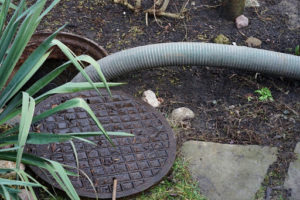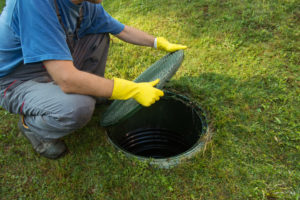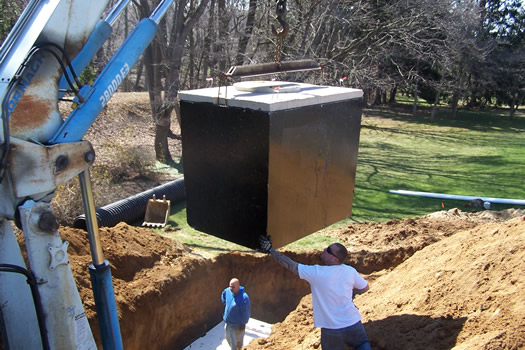Septic Pumping Pricing
Fixed Rate Pricing
$325 up to 1500 Gallons
$0.14 per gallon over 1500 gallons
Emergency Service Available Within 24 Hours
$100 fee for same-day service
Full Time Occupancy & Recommended Frequency
1 Occupant = 3 Years
2-3 Occupants = 2 Years
4+ Occupants = Annually
Homes outside of cities that do not have access to a city sewer, rely on septic tank systems. Rather than pumping waste through sewer mains to a central sewage processing plant, septic systems pump solid and liquid waste from the house into pipes that lead to an underground tank.
Routine septic tank pumping, is the best way to avoid any unexpected problems with your system. It will help you avoid messy backups and can even extend the life of your septic tank.
How a Septic System Works
Septic systems are used across America to treat waste within their homes. By design, these systems are fairly simple. All drains in the home converge to a single pipe that leads to the septic tank buried outside. When the waste water from your toilet, shower, sinks and washing machine leave your home, it’s combined. The liquid flows with the help of simple gravity, or it may be moved along by an electric pump. When it hits the septic tank, however, it begins to separate.
How Do Septic Tanks Work?
A septic tank is simply a big concrete or steel tank buried under the ground in your yard and is a storage tank for sewage, and human waste.
The septic system works with the septic tank as it passes the wastewater to the septic tank and the tank holds the waste material long enough for the solids to settle to the bottom as oil, grease, and liquids. A scum layer floats to the top.
As new water enters the tank, it displaces the water that’s already there. This water flows out of the septic tank and into a series of porous pipes to a drainage field or drain field (also called a leach field), or a soil absorption field.
The organic liquid will be discharged into the soil and will fertilize it. As the liquids slowly filter down through the soil, the liquid waste is being filtered down to groundwater supplies, it is virtually sterile clean water.
Meanwhile, the solids in the septic tank break down under the affect of anaerobic bacteria, creating a sludge layer that collects in the bottom of the septic tank.
Septic Tank Pumping Process
The tank pumping septic service removes the sludge layer from the bottom of the septic tank, and this needs to be done before the sludge builds up to a level where it blocks the outlet pipe through which liquids flow into the drain field.
The septic tank must be pumped through the two large central access ports (manholes), not the small inlet or outlet inspection port location above each baffle. If a septic tank is pumped through the baffle inspection ports, this can damage the baffles and yield incomplete removal of sludge and scum.
Biomat
As more solids accumulate in the absorption area, these solids begin to clog the soil and restrict the movement of wastewater into the soil. By that time, sewage has backed up into the home.
The soil absorption area is clogged with a nearly impermeable biomat and flooded with wastewater because the soil is no longer able to absorb the wastewater produced on a daily basis.
Removal of these biomats is usually expensive and time consuming. Pumping the septic tank will not remove the biomat. Removing the biomat requires that you pump the wastewater ponded in the soil absorption area.
How Often Is a Septic Tank Pumped?
It is best practice to have a septic tank inspected every two to three years, with septic tank pumping typically required every three to five years to empty the septic tank before a plumbing problem occurs.
It’s hard to generalize how quickly septic tank pumping is needed to be pumped, there are certain factors that weigh in on the frequency with which this needs to be done such as:
Size of Household
Larger households generate more waste, and thus fill up the septic tank faster. Homes with growing families including children ranging from small children to teenagers usually flush toilets, showers, and sinks more often. This uses more water and puts more materials into the septic tank.
On the other hand, empty nesters, and especially the elderly tend to use much less water and put smaller amounts of solids into septic tanks.
How Much Wastewater is Generated in Septic Tanks
In most cases, the excess amount of sewage flowing into the septic tank can affect how fast the septic tank fills up.
The Amount of Solids in the Wastewater
Households with more than one toilet (many toilets), or use a garbage disposal frequently tend to fill up the septic tank quicker.
Septic Tank Size
Larger septic tanks can hold more solid sludge, and require less frequent pumping. Most septic tanks that have electrical float switches, a pump, or mechanical components need to be inspected more often, typically once each year.
What Are the Signs Your Septic System is Full?
Homeowners often question when the septic tank will be full, and rightly so. If a homeowner waits too long or ignores the signs, they may end up with the most obvious sign, a sewage backup. Some other signs your tank is close to full are:
- Strong odors coming up drains like the sink, dishwasher, garbage disposal, or washing machines
- Chronic slow drains, draining of pipes
- Water pooling around the ground of the septic tank site in your yard
- Luscious green grass near septic tank site that appears healthier than normal grass
Maintenance of Your Septic Tank System
Here are several proactive measures homeowners can take to ensure that your septic system operates efficiently and to help reduce the frequency that pumping is necessary:
- Reduce water usage. Using high-efficiency toilets, water-saving plumbing toilets and faucets can greatly decrease the amount of water that goes into the septic system.
- Routine maintenance checks: Fix leaks and drips to reduce the overuse of water that can cause the septic tank to fill faster.
- Reduce solid wastes: Monitoring the solid waste that enters the septic system is another way to keep it working properly. Don’t flush anything other than toilet paper down the toilet, and avoid using a garbage disposal that puts organic food wastes into the septic system. Throw this trash into the garbage or use it for compost in a garden.
- Direct rainwater away from the drain field. Move any downspouts and landscape grading that funnel water onto the septic system drain field. This can interfere with its ability to disperse water from the septic system.
- Don’t drain hot tubs into the drain system. This can put undue stress on the septic system. Drain water from hot tubs or swimming pools into the yard, away from the drain field.
- Avoid putting chemicals down sink drains. Chemicals can interfere with the bacterial action that breaks down solid wastes, so avoid flushing them down the drain. This also includes various commercial septic tank additives, which generally do more harm than good. Unless a trusted septic service professional has prescribed such an additive, do not use any septic tank chemicals.
Calling for Septic System Service
If you have septic system concerns, there are several things to consider. You need to know the basics about how your septic tank works and inspect what might have caused it to become backed up or clogged. It’s also essential to understand when you should call in professionals like Delaware Valley Septic, Sewer & Storm for assistance.
We can help assess the situation and provide recommendations on what needs to be done for the job before starting any work that will be required on your property. For all of your septic pumping concerns, septic system repair ore replacement services, contact us today!





